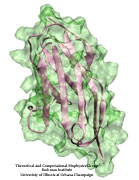Highlights of our Work
2024 | 2023 | 2022 | 2021 | 2020 | 2019 | 2018 | 2017 | 2016 | 2015 | 2014 | 2013 | 2012 | 2011 | 2010 | 2009 | 2008 | 2007 | 2006 | 2005 | 2004 | 2003 | 2002 | 2001

image size:
300.4KB
made with VMD
The living state of biological cells manifests itself through mechanical motion on many
length scales. Behind this motion are processes that generate and transform
mechanical forces of various types. As with other cell functions, the machinery for
cellular mechanics involves proteins. Their flexible structures can be deformed
and restored, and are often essential for handling, transforming, and using mechanical
force. For instance, proteins of muscle and the extracellular matrix exhibit salient
elasticity upon stretching, mechanosensory proteins transduce
weak mechanical stimuli into electrical signals, and so-called regulatory proteins force
DNA into loops controlling, thereby, gene expression. In a recent
review, the
structure-function relationship of four protein complexes with well defined
and representative mechanical functions has been described. The first protein system
reviewed is titin, a protein that confers passive elasticity on muscle. The second
system reviewed is the elastic extracellular matrix protein fibronectin and its
cellular receptor integrin. The third protein system covered are the proteins cadherin
and ankyrin involved in the transduction apparatus of mechanical senses and hearing. The
last system surveyed is the lac repressor, a protein which regulates gene
expression by looping DNA. In each case, molecular dynamics simulations using
NAMD provided insights
into the physical mechanisms underlying the associated mechanical functions of living
cells. (more on our mechanobiology web
site).



